List of even-toed ungulates by population

| Mammals by population |
|---|
 |
This is a list of even-toed ungulate species by estimated global population. This list is not comprehensive, as not all ungulates have had their numbers quantified.
| Common name | Binomial name | Population | Status | Trend | Notes | Image |
|---|---|---|---|---|---|---|
| Saola | Pseudoryx nghetinhensis | <750 | CR[1] | Maximum estimate. No individuals in captivity. Wild population highly dispersed, and subpopulations fragmented with numbers of mature individuals below the minimum viable population. Foremost threatened by hunting.[1] |  | |
| Pygmy hog | Porcula salvania | 250[2] | EN[2] | Maximum estimate for mature individuals.[2] |  | |
| Bawean deer | Axis kuhlii | 200–500[3] | CR[3] | Estimates are for the wild population only; may reach as high as 500.[3] |  | |
| Addax | Addax nasomaculatus | 30–90[4] | CR[4] | Maximum estimate for the wild.[4] |  | |
| Tamaraw | Bubalus mindorensis | 300[5] | CR[5] | 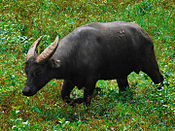 | ||
| Togian babirusa | Babyrousa togeanensis | 500[6] | EN[6] | Maximum estimate.[6] |  | |
| Walia ibex | Capra walie | 500[7] | VU[7] |  | ||
| Dama gazelle | Nanger dama | 500[8] | CR[8] | Maximum estimate.[8] | 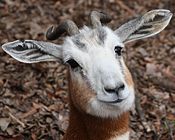 | |
| Hirola | Beatragus hunteri | 500–2000[9] | CR[9] | May be much lower.[9] |  | |
| Anhui musk deer | Moschus anhuiensis | 700–800[10] | EN[10] | Most recent estimate was in 1998.[10] | ||
| Przewalski's gazelle | Procapra przewalskii | 700–800[11] | EN[11] | Could be underestimated.[11] |  | |
| Persian fallow deer | Dama mesopotamica | 715[12] | EN[12] | Previously thought to be extinct.[12] |  | |
| Wild Bactrian camel | Camelus ferus | 950[13] | CR[13] | The latest estimate for the population of the Wild Camel was conducted in 2008.[13] |  | |
| South Andean deer | Hippocamelus bisulcus | 1048–1500[14] | EN[14] |  | ||
| Calamian deer | Axis calamianensis | 1123[15] | EN[15] | 1994 estimate; has almost certainly decreased.[15] |  | |
| Abbott's duiker | Cephalophus spadix | 1500[16] | EN[16] | Maximum estimate.[16] | ||
| Cuvier's gazelle | Gazella cuvieri | 1750–2950[17] | VU[17] | unknown[17] |  | |
| Nilgiri tahr | Nilgiritragus hylocrius | 1800–2000[18] | EN[18] | Last estimate for the Nilgiri Tahr was conducted in 2008.[18] |  | |
| Pygmy hippopotamus | Choeropsis liberiensis | 2000–3000[19] | EN[19] | Estimate is from 1993; numbers have probably shrunk.[19] |  | |
| Mountain anoa | Bubalus quarlesi | 2500[20] | EN[20] | Maximum estimate.[20] |  | |
| Rhim gazelle | Gazella leptoceros | 2500[21] | EN[21] | Estimate is for mature individuals only.[21] | 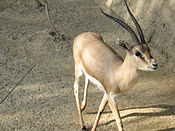 | |
| Visayan spotted deer | Rusa alfredi | 2500[22] | EN[22] | Maximum estimate.[22] |  | |
| Mountain nyala | Tragelaphus buxtoni | 2500–4000[23] | EN[23] | 2500 is a maximum estimate from 1999, but recent work has shown numbers may be as high as 4000.[23] |  | |
| European bison | Bison bonasus | 3200[24] | NT[24] | Includes 1400 semi-domestic animals and 1800 wild. Semi-domestic numbers are likely underestimated.[24] |  | |
| Chacoan peccary | Catagonus wagneri | 3200[25] | EN[25] | Estimate was made in 2002; wide-scale deforestation of their habitat began in 2003.[25] |  | |
| Wild water buffalo | Bubalus arnee | 3400[26] | EN |  | ||
| Jentink's duiker | Cephalophus jentinki | 3500[27] | EN[27] | Maximum estimate; may be less than 2000.[27] |  | |
| Barasingha | Rucervus duvaucelii | 3500–5100[28] | VU[28] |  | ||
| Nile lechwe | Kobus megaceros | 4291[29] | EN[29] |  | ||
| Small red brocket | Mazama bororo | 4500[30] | VU[30] | Maximum estimate.[30] | ||
| Arabian tahr | Arabitragus jayakari | 5000[31] | EN[31] | Maximum estimate.[31] |  | |
| West Caucasian tur | Capra caucasica | 4000–5000[32] | EN[32] |  | ||
| Barbary sheep | Ammotragus lervia | 5000–10000[33] | VU[33] |  | ||
| Beira | Dorcatragus megalotis | 7000[34] | VU[34] | |||
| Arabian oryx | Oryx leucoryx | 7000–8000[35] | VU[35] | 6000–7000 in captivity and c. 1000 in the wild.[35] |  | |
| Hairy-fronted muntjac | Muntiacus crinifrons | 7000–8500[36] | VU[36] | Most recent estimate was in 1998.[36] |  | |
| Banteng | Bos javanicus | 8000[37] | EN[37] | Maximum estimate; may be fewer than 5000. Numbers do not include the non-purebred domestic variety.[37] |  | |
| Markhor | Capra falconeri | 9700[38] | NT[38] | Estimate includes approximately 900 animals assumed to live in areas for which data is unavailable.[38] |  | |
| Nubian ibex | Capra nubiana | 5000[39] | VU[39] | Estimate for mature individuals only due to some areas lacking population estimates.[39] |  | |
| Southern pudú | Pudu puda | 10000[40] | NT[40] | Maximum estimate.[40] |  | |
| Red goral | Naemorhedus baileyi | 10000[41] | VU[41] | Maximum estimate for mature individuals.[41] |  | |
| Four-horned antelope | Tetracerus quadricornis | 10000[42] | VU[42] |  | ||
| Javan rusa | Rusa timorensis | 10000[43] | VU[43] | Maximum estimate for mature individuals.[22] |  | |
| Taruca | Hippocamelus antisensis | 12000–17000[44] | VU[44] | 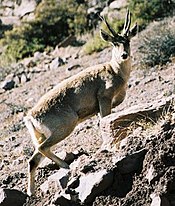 | ||
| Gaur | Bos gaurus | 13000–30000[45] | VU[45] | 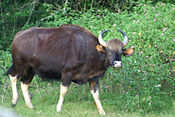 | ||
| Soemmerring's gazelle | Nanger soemmerringii | 14000[46] | VU[46] |  | ||
| Mountain gazelle | Gazella gazella | 15000[47] | EN[47] | Maximum estimate.[47] |  | |
| Wild yak | Bos mutus | 15000[48] | VU[48] | Estimate is from 1995.[48] |  | |
| Giant eland | Tragelaphus derbianus | 15000–20000[49] | VU[49] |  | ||
| Black wildebeest | Connochaetes gnou | 18000[50] | LC[50] | Minimum estimate (11000 wild and 7000 semi-domesticated).[50] | 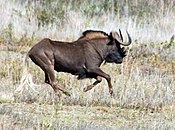 | |
| Grey rhebok | Pelea capreolus | 18000[51] | NT[51] |  | ||
| Harvey's duiker | Cephalophus harveyi | 20000[52] | LC[52] | Numbers may be overestimated.[52] |  | |
| Pampas deer | Ozotoceros bezoarticus | 20000–80000[53] | NT[53] |  | ||
| Red-fronted gazelle | Eudorcas rufifrons | 25000[54] | VU[54] |  | ||
| Zebra duiker | Cephalophus zebra | 28000[55] | VU[55] | Could be overestimated; may be less than 15000.[55] |  | |
| Bongo | Tragelaphus eurycerus | 28000[56] | NT[56] | Two subspecies: Mountain (75–140) and Lowland (28000).[56] |  | |
| Alpine ibex | Capra ibex | 30000[57] | LC[57] | Was as low as 100 individuals in the 1800s.[57] |  | |
| Silver dik-dik | Madoqua piacentinii | 30000[58] | DD[58] | Possibly overestimated.[58] | ||
| Nyala | Tragelaphus angasii | 32000[59] | LC[59] |  | ||
| Ogilby's duiker | Cephalophus ogilbyi | 35000[60] | LC[60] |  | ||
| Okapi | Okapia johnstoni | 35000–50000[61] | EN[61] |  | ||
| Mountain reedbuck | Redunca fulvorufula | 36000[62] | EN[62] | Minimum estimate, divided into three subspecies: Southern (33000), Chanler's (2900), and Western (450).[62] |  | |
| Red forest duiker | Cephalophus natalensis | 42000[63] | LC[63] | Numbers may be underestimated.[63] |  | |
| Klipspringer | Oreotragus oreotragus | 42000[64] | LC[64] | Estimate is considered conservative.[64] |  | |
| Blackbuck | Antilope cervicapra | 50000[65] | NT[65] | Numbers have increased from 20000–24000 in the 1970s.[65] |  | |
| Spanish ibex | Capra pyrenaica | 50000[66] | LC[66] | Numbered only c. 7900 in the early 1990s.[66] |  | |
| Royal antelope | Neotragus pygmaeus | 62000[67] | LC[67] | Possibly underestimated.[67] |  | |
| East African oryx | Oryx beisa | 67000[68] | EN[68] | Divided into two subspecies: Beisa (50000) and Fringe-eared (17000).[68] |  | |
| Bighorn sheep | Ovis canadensis | 70000[69] | LC[69] | Estimate was made in 2010.[69] |  | |
| Southern reedbuck | Redunca arundinum | 73000[70] | LC[70] |  | ||
| Sable antelope | Hippotragus niger | 75000[71] | LC[71] |  | ||
| Roan antelope | Hippotragus equinus | 76000[72] | LC[72] |  | ||
| Mountain goat | Oreamnos americanus | 80000–119000[73] | LC[73] |  | ||
| Gerenuk | Litocranius walleri | 95000[74] | NT[74] | 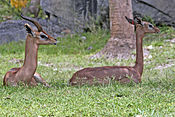 | ||
| Sharpe's grysbok | Raphicerus sharpei | 95000[75] | LC[75] | Difficult to study due to the animal's nocturnal nature; numbers may be underestimated.[75] |  | |
| Japanese serow | Capricornis crispus | 100000[76] | LC[76] |  | ||
| Black duiker | Cephalophus niger | 100000[77] | LC[77] |  | ||
| Bohor reedbuck | Redunca redunca | 101000[78] | LC[78] | Probably underestimated.[78] |  | |
| Wild goat | Capra aegagrus | 110000[79] | NT[79] | Minimum estimate, due to lacking population data in some areas.[79] |  | |
| Dall sheep | Ovis dalli | 111500–116500[80] | LC[80] | Consists of approximately 41500 sheep in Canada and between 70000 and 75000 animals in the United States.[80] |  | |
| Hippopotamus | Hippopotamus amphibius | 115000–130000[81] | VU[81] |  | ||
| Lesser kudu | Tragelaphus imberbis | 118000[82] | NT[82] | Minimum estimate.[82] |  | |
| Goitered gazelle | Gazella subgutturosa | 120000–140000[83] | VU[83] |  | ||
| Puku | Kobus vardonii | 130000[84] | NT[84] |  | ||
| Muskox | Ovibos moschatus | 135000[85] | LC[85] | Estimate includes 75400 animals in the Northwest Territories, 45300 in Nunavut, 3714 in Alaska, and between 9500 and 12500 in Greenland.[85] |  | |
| Common eland | Tragelaphus oryx | 136000[86] | LC[86] |  | ||
| Yellow-backed duiker | Cephalophus silvicultor | 160000[87] | NT[87] |  | ||
| Saiga antelope | Saiga tatarica | 165000[88] | NT[88] | Numbers stood at 1250000 in the mid-1970s.[88] | ||
| Red-flanked duiker | Cephalophus rufilatus | 170000[89] | LC[89] |  | ||
| Sitatunga | Tragelaphus spekii | 170000[90] | LC[90] | Yet-to-be-published research suggests the population has been overestimated.[90] |  | |
| Siberian ibex | Capra sibirica | 170000–250000[91] | NT[91] | 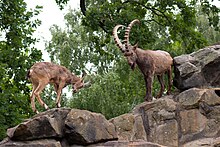 | ||
| Weyns's duiker | Cephalophus weynsi | 188000[92] | LC[92] | |||
| Waterbuck | Kobus ellipsiprymnus | 200000[93] | LC[93] | About 95000 of the Defassa subspecies and 105000 of the Common.[93] |  | |
| Lechwe | Kobus leche | 212000[94] | NT[94] | Combined numbers of three subspecies: Red (98000), Kafue (78000), and Black (36000).[94] | 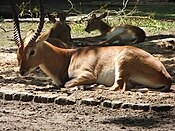 | |
| Bates's pygmy antelope | Neotragus batesi | 219000[95] | LC[95] |  | ||
| Water chevrotain | Hyemoschus aquaticus | 278000[96] | LC[96] |  | ||
| White-bellied duiker | Cephalophus leucogaster | 287000[97] | NT[97] | |||
| Black-fronted duiker | Cephalophus nigrifrons | 300000[98] | LC[98] |  | ||
| Vicuña | Vicugna vicugna | 350000[99] | LC[99] |  | ||
| Grant's gazelle | Nanger granti | 350000[100] | LC[100] |  | ||
| Hartebeest | Alcelaphus buselaphus | 362000[101] | LC[101] |  | ||
| Suni | Nesotragus moschatus | 365000[102] | LC[102] |  | ||
| Gemsbok | Oryx gazella | 373000[103] | LC[103] |  | ||
| Peters's duiker | Cephalophus callipygus | 382000[104] | LC[104] |  | ||
| Greater kudu | Tragelaphus strepsiceros | 482000[105] | LC[105] |  | ||
| Salt's dik-dik | Madoqua saltiana | 485600[106] | LC[106] |  | ||
| Günther's dik-dik | Madoqua guentheri | 511000[107] | LC[107] |  | ||
| American bison | Bison bison | 530000[108] | NT[108] | Includes 500000 semi-domestic animals and 30000 wild (19000 plains bison and 11000 wood bison).[108] |  | |
| Thomson's gazelle | Eudorcas thomsonii | 550000[109] | LC[109] |  | ||
| Steenbok | Raphicerus campestris | 600000[110] | LC[40] | Considered an underestimate.[110] |  | |
| Pronghorn | Antilocapra americana | 700000[111] | LC[111] | Numbered over 35000000 in the early 1800s and as little as 20000 in the early 1920s.[111] |  | |
| Bay duiker | Cephalophus dorsalis | 725000[112] | NT[112] |  | ||
| Oribi | Ourebia ourebi | 750000[113] | LC[113] |  | ||
| African buffalo | Syncerus caffer | 890000[114] | NT[114] | Considered conservative. Divided into four subspecies: West African Savanna (27000), Central African Savanna (133000), Southern Savanna (670000), and Forest (60000).[114] |  | |
| Kirk's dik-dik | Madoqua kirkii | 971000[115] | LC[115] |  | ||
| Siberian roe deer | Capreolus pygargus | 1000000[116] | LC[116] | About 500000 were hunted annually in Russia in the 1800s.[116] |  | |
| Bushbuck | Tragelaphus scriptus | 1340000[117] | LC[117] | Estimate is considered conservative.[117] |  | |
| Guanaco | Lama guanicoe | 1000000[118] | LC[118] |  | ||
| Moose | Alces alces | 1500000[119] | LC[119] |  | ||
| Blue wildebeest | Connochaetes taurinus | 1550000[120] | LC[120] |  | ||
| Common duiker | Sylvicapra grimmia | 1660000[121] | LC[121] | Considered extremely conservative; yet-to-be-published research shows it may number as high as 10000000.[121] |  | |
| Impala | Aepyceros melampus | 2000000[122] | LC[122] |  | ||
| Springbok | Antidorcas marsupialis | 2000000–2500000[123] | LC[123] |  | ||
| Maxwell's duiker | Philantomba maxwellii | 2137000[124] | LC[124] | Quite possibly underestimated.[124] |  | |
| Mongolian gazelle | Procapra gutturosa | 2140000[125] | LC[125] | Unknown[125] | Estimate has dropped from 2700000 since 1998.[125] | 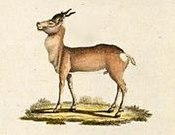 |
| Blue duiker | Philantomba monticola | 7000000[126] | LC[126] | Estimate is considered conservative.[126] |  | |
| White-tailed deer | Odocoileus virginianus | 11500000[127] | LC[127] | Estimated population in the United States and Canada only, with estimate of 11000000 in the US considered a minimum.[127] |  | |
| Water buffalo | Bubalus bubalis | 172000000[128] | Domesticated | incl. 3200000 Carabao in the Philippines |  | |
| Domestic goat | Capra hircus | 850000000[129] | Domesticated |  | ||
| Cattle | Bos taurus | 1500000000[130] | Domesticated |  | ||
| Domestic pig | Sus domesticus | 1000000000[131] | Domesticated |  | ||
| Domestic sheep | Ovis aries | 1000000000[131] | Domesticated |  |
See also
[edit]References
[edit]- ^ a b c Timmins, R. J., Hedges, S. & Robichaud, W. G. (2016). "Pseudoryx nghetinhensis". IUCN Red List of Threatened Species. 2016: e.T18597A46364962. doi:10.2305/IUCN.UK.2016-2.RLTS.T18597A46364962.en. Retrieved 15 January 2018.
{{cite journal}}: CS1 maint: multiple names: authors list (link) - ^ a b c d Narayan, G., Deka, P. & Oliver, W. (2008). "Porcula salvania". IUCN Red List of Threatened Species. 2008: e.T21172A9254675. doi:10.2305/IUCN.UK.2008.RLTS.T21172A9254675.en. Retrieved 15 January 2018.
{{cite journal}}: CS1 maint: multiple names: authors list (link) - ^ a b c d Semiadi, G.; Duckworth, J.W.; Timmins, R. (2015). "Axis kuhlii". IUCN Red List of Threatened Species. 2015: e.T2447A73071875. doi:10.2305/IUCN.UK.2015-2.RLTS.T2447A73071875.en. Retrieved 20 November 2021.
- ^ a b c d IUCN SSC Antelope Specialist Group (2016). "Addax nasomaculatus". IUCN Red List of Threatened Species. 2016: e.T512A50180603. doi:10.2305/IUCN.UK.2016-2.RLTS.T512A50180603.en. Retrieved 20 November 2021.
- ^ a b c Boyles, R.; Schutz, E.; de Leon, J. (2016). "Bubalus mindorensis". IUCN Red List of Threatened Species. 2016: e.T3127A50737640. doi:10.2305/IUCN.UK.2016-2.RLTS.T3127A50737640.en. Retrieved 20 November 2021.
- ^ a b c d Macdonald, A.; Leus, K.; Masaaki, I.; Burton, J. (2016). "Babyrousa togeanensis". IUCN Red List of Threatened Species. 2016: e.T136472A44143172. doi:10.2305/IUCN.UK.2016-1.RLTS.T136472A44143172.en. Retrieved 20 November 2021.
- ^ a b c Ejigu, D. (2020). "Capra walie". IUCN Red List of Threatened Species. 2020: e.T3797A178652661. doi:10.2305/IUCN.UK.2020-2.RLTS.T3797A178652661.en. Retrieved 20 November 2021.
- ^ a b c d IUCN SSC Antelope Specialist Group (2016). "Nanger dama". IUCN Red List of Threatened Species. 2016: e.T8968A50186128. doi:10.2305/IUCN.UK.2016-2.RLTS.T8968A50186128.en. Retrieved 20 November 2021.
- ^ a b c d IUCN SSC Antelope Specialist Group (2017). "Beatragus hunteri". IUCN Red List of Threatened Species. 2017: e.T6234A50185297. doi:10.2305/IUCN.UK.2017-2.RLTS.T6234A50185297.en. Retrieved 20 November 2021.
- ^ a b c d Wang, Y.; Harris, R.B. (2015). "Moschus anhuiensis". IUCN Red List of Threatened Species. 2015: e.T136643A61979276. doi:10.2305/IUCN.UK.2015-4.RLTS.T136643A61979276.en. Retrieved 20 November 2021.
- ^ a b c d IUCN SSC Antelope Specialist Group (2016). "Procapra przewalskii". IUCN Red List of Threatened Species. 2016: e.T18230A50192807. doi:10.2305/IUCN.UK.2016-3.RLTS.T18230A50192807.en. Retrieved 20 November 2021.
- ^ a b c d Rabiei, A. & Saltz, D. (2011). "Dama mesopotamica". IUCN Red List of Threatened Species. 2011. Retrieved 2012-11-11.
- ^ a b c d Hare, J. (2008). "Camelus ferus". IUCN Red List of Threatened Species. 2008: e.T63543A12689285. doi:10.2305/IUCN.UK.2008.RLTS.T63543A12689285.en. Retrieved 20 November 2021.
- ^ a b c Black-Decima, P.A.; Corti, P.; Díaz, N.; Fernandez, R.; Geist, V.; Gill, R.; Gizejewski, Z.; Jiménez, J.; Pastore, H.; Saucedo, C.; Wittmer, H. (2016). "Hippocamelus bisulcus". IUCN Red List of Threatened Species. 2016: e.T10054A22158895. doi:10.2305/IUCN.UK.2016-1.RLTS.T10054A22158895.en. Retrieved 20 November 2021.
- ^ a b c d Widmann, P.; Lastica, E. (2015). "Axis calamianensis". IUCN Red List of Threatened Species. 2015: e.T2446A22156678. doi:10.2305/IUCN.UK.2015-2.RLTS.T2446A22156678.en. Retrieved 20 November 2021.
- ^ a b c d Moyer, D.; Jones, T.; Rovero, F. (2016). "Cephalophus spadix". IUCN Red List of Threatened Species. 2016: e.T4151A50184413. doi:10.2305/IUCN.UK.2016-1.RLTS.T4151A50184413.en. Retrieved 20 November 2021.
- ^ a b c IUCN SSC Antelope Specialist Group (2016). "Gazella cuvieri". IUCN Red List of Threatened Species. 2016: e.T8967A50186003. doi:10.2305/IUCN.UK.2016-2.RLTS.T8967A50186003.en. Retrieved 20 November 2021.
- ^ a b c d Alempath, M.; Rice, C. (2008). "Nilgiritragus hylocrius". IUCN Red List of Threatened Species. 2008: e.T9917A13026736. doi:10.2305/IUCN.UK.2008.RLTS.T9917A13026736.en. Retrieved 20 November 2021.
- ^ a b c d Ransom, C.; Robinson, P.T.; Collen, B. (2015). "Choeropsis liberiensis". IUCN Red List of Threatened Species. 2015: e.T10032A18567171. doi:10.2305/IUCN.UK.2015-2.RLTS.T10032A18567171.en. Retrieved 20 November 2021.
- ^ a b c d Burton, J.; Wheeler, P.; Mustari, A. (2016). "Bubalus quarlesi". IUCN Red List of Threatened Species. 2016: e.T3128A46364433. doi:10.2305/IUCN.UK.2016-2.RLTS.T3128A46364433.en. Retrieved 20 November 2021.
- ^ a b c d IUCN SSC Antelope Specialist Group (2016). "Gazella leptoceros". IUCN Red List of Threatened Species. 2016: e.T8972A50186909. doi:10.2305/IUCN.UK.2016-2.RLTS.T8972A50186909.en. Retrieved 20 November 2021.
- ^ a b c d e Brook, S.M. (2016). "Rusa alfredi". IUCN Red List of Threatened Species. 2016: e.T4273A22168782. doi:10.2305/IUCN.UK.2016-2.RLTS.T4273A22168782.en. Retrieved 20 November 2021.
- ^ a b c d Sillero-Zubiri, C. (2008). "Tragelaphus buxtoni". IUCN Red List of Threatened Species. 2008. Retrieved 2012-11-12.
- ^ a b c d Plumb, G.; Kowalczyk, R.; Hernandez-Blanco, J.A. (2020). "Bison bonasus". IUCN Red List of Threatened Species. 2020: e.T2814A45156279. doi:10.2305/IUCN.UK.2020-3.RLTS.T2814A45156279.en. Retrieved 20 November 2021.
- ^ a b c d Altrichter, M.; Taber, A.; Noss, A.; Maffei, L.; Campos, J. (2015). "Catagonus wagneri". IUCN Red List of Threatened Species. 2015: e.T4015A72587993. doi:10.2305/IUCN.UK.2015-2.RLTS.T4015A72587993.en. Retrieved 20 November 2021.
- ^ Choudhury, A. (2010). The vanishing herds : the wild water buffalo. Gibbon Books, Rhino Foundation, CEPF & COA, Taiwan, Guwahati, India.
- ^ a b c d IUCN SSC Antelope Specialist Group (2016). "Cephalophus jentinki". IUCN Red List of Threatened Species. 2016: e.T4140A50182687. doi:10.2305/IUCN.UK.2016-1.RLTS.T4140A50182687.en. Retrieved 20 November 2021.
- ^ a b c Duckworth, J.W.; Kumar, N.S.; Pokharel, C.P.; Sagar Baral, H.; Timmins, R. (2015). "Rucervus duvaucelii". IUCN Red List of Threatened Species. 2015: e.T4257A22167675. doi:10.2305/IUCN.UK.2015-4.RLTS.T4257A22167675.en. Retrieved 20 November 2021.
- ^ a b c IUCN SSC Antelope Specialist Group (2017). "Kobus megaceros". IUCN Red List of Threatened Species. 2017: e.T11034A50189177. doi:10.2305/IUCN.UK.2017-2.RLTS.T11034A50189177.en. Retrieved 20 November 2021.
- ^ a b c d Vogliotti, A.; Oliveira, M.L.; Duarte, J.M.B (2016). "Mazama bororo". IUCN Red List of Threatened Species. 2016: e.T41023A22155086. doi:10.2305/IUCN.UK.2016-1.RLTS.T41023A22155086.en. Retrieved 20 November 2021.
- ^ a b c d Ross, S.; Al-Rawahi, H.; Al-Jahdhami, M.H.; Spalton, J.A.; Mallon, D.; Al-Shukali, A.S.; Al-Rasbi, A.; Al-Fazari, W.; Chreiki, M.K. (2019). "Arabitragus jayakari". IUCN Red List of Threatened Species. 2019: e.T9918A156925170. doi:10.2305/IUCN.UK.2019-1.RLTS.T9918A156925170.en. Retrieved 20 November 2021.
- ^ a b c Weinberg, P. (2019-11-29). "Capra caucasica". The IUCN Red List of Threatened Species 2020: e.T3794A22143809. doi:10.2305/iucn.uk.2020-2.rlts.t3794a22143809.en. S2CID 240704447.
- ^ a b c Cassinello, J.; Cuzin, F.; Jdeidi, T.; Masseti, M.; Nader, I.; de Smet, K. (2008). "Ammotragus lervia". IUCN Red List of Threatened Species. 2008: e.T1151A3288917. doi:10.2305/IUCN.UK.2008.RLTS.T1151A3288917.en. Retrieved 20 November 2021.
- ^ a b c IUCN SSC Antelope Specialist Group (2016). "Dorcatragus megalotis". IUCN Red List of Threatened Species. 2016: e.T6793A50185898. doi:10.2305/IUCN.UK.2016-1.RLTS.T6793A50185898.en. Retrieved 20 November 2021.
- ^ a b c d IUCN SSC Antelope Specialist Group (2017). "Oryx leucoryx". IUCN Red List of Threatened Species. 2017: e.T15569A50191626. doi:10.2305/IUCN.UK.2017-2.RLTS.T15569A50191626.en. Retrieved 20 November 2021.
- ^ a b c d Timmins, R.; Chan, B. (2016). "Muntiacus crinifrons". IUCN Red List of Threatened Species. 2016: e.T13924A22160753. doi:10.2305/IUCN.UK.2016-1.RLTS.T13924A22160753.en. Retrieved 20 November 2021.
- ^ a b c d Gardner, P.; Hedges, S.; Pudyatmoko, S.; Gray, T.N.E.; Timmins, R.J. (2016). "Bos javanicus". IUCN Red List of Threatened Species. 2016: e.T2888A46362970. doi:10.2305/IUCN.UK.2016-2.RLTS.T2888A46362970.en. Retrieved 20 November 2021.
- ^ a b c d Michel, S. & Rosen Michel, T. (2015). "Capra falconeri". IUCN Red List of Threatened Species. 2015. Retrieved 2018-04-09.
{{cite journal}}: CS1 maint: multiple names: authors list (link) - ^ a b c d Ross, S.; Elalqamy, H.; Al Said, T.; Saltz, D. (2020). "Capra nubiana". IUCN Red List of Threatened Species. 2020: e.T3796A22143385. doi:10.2305/IUCN.UK.2020-2.RLTS.T3796A22143385.en. Retrieved 20 November 2021.
- ^ a b c d e Silva-Rodríguez, E.; Pastore, H.; Jiménez, J. (2016). "Pudu puda". IUCN Red List of Threatened Species. 2016: e.T18848A22164089. doi:10.2305/IUCN.UK.2016-1.RLTS.T18848A22164089.en. Retrieved 20 November 2021.
- ^ a b c d Nijhawan, S. (2020). "Naemorhedus baileyi". IUCN Red List of Threatened Species. 2020: e.T14294A179947455. doi:10.2305/IUCN.UK.2020-3.RLTS.T14294A179947455.en. Retrieved 20 November 2021.
- ^ a b c IUCN SSC Antelope Specialist Group (2017). "Tetracerus quadricornis". IUCN Red List of Threatened Species. 2017: e.T21661A50195368. doi:10.2305/IUCN.UK.2017-2.RLTS.T21661A50195368.en. Retrieved 20 November 2021.
- ^ a b c Hedges, S.; Duckworth, J.W.; Timmins, R.; Semiadi, G.; Dryden, G. (2015). "Rusa timorensis". IUCN Red List of Threatened Species. 2015: e.T41789A22156866. doi:10.2305/IUCN.UK.2015-2.RLTS.T41789A22156866.en. Retrieved 20 November 2021.
- ^ a b c Barrio, J.; Nuñez, A.; Pacheco, L.; Regidor, H.A.; Fuentes-Allende, N. (2017). "Hippocamelus antisensis". IUCN Red List of Threatened Species. 2017: e.T10053A22158621. doi:10.2305/IUCN.UK.2017-2.RLTS.T10053A22158621.en. Retrieved 20 November 2021.
- ^ a b c Duckworth, J.W.; Sankar, K.; Williams, A.C.; Samba Kumar, N.; Timmins, R.J. (2016). "Bos gaurus". IUCN Red List of Threatened Species. 2016: e.T2891A46363646. doi:10.2305/IUCN.UK.2016-2.RLTS.T2891A46363646.en. Retrieved 20 November 2021.
- ^ a b c IUCN SSC Antelope Specialist Group (2016). "Nanger soemmerringii". IUCN Red List of Threatened Species. 2016: e.T63541A50197739. doi:10.2305/IUCN.UK.2016-2.RLTS.T63541A50197739.en. Retrieved 20 November 2021.
- ^ a b c d IUCN SSC Antelope Specialist Group (2017). "Gazella gazella". IUCN Red List of Threatened Species. 2017: e.T8989A50186574. doi:10.2305/IUCN.UK.2017-2.RLTS.T8989A50186574.en. Retrieved 20 November 2021.
- ^ a b c d Buzzard, P.; Berger, J. (2016). "Bos mutus". IUCN Red List of Threatened Species. 2016: e.T2892A101293528. doi:10.2305/IUCN.UK.2016-2.RLTS.T2892A101293528.en. Retrieved 20 November 2021.
- ^ a b c IUCN SSC Antelope Specialist Group (2017). "Tragelaphus derbianus". IUCN Red List of Threatened Species. 2017: e.T44172A50197518. doi:10.2305/IUCN.UK.2017-2.RLTS.T44172A50197518.en. Retrieved 20 November 2021.
- ^ a b c d Vrahimis, S.; Grobler, P.; Brink, J.; Viljoen, P.; Schulze, E. (2017). "Connochaetes gnou". IUCN Red List of Threatened Species. 2017: e.T5228A50184962. doi:10.2305/IUCN.UK.2017-2.RLTS.T5228A50184962.en. Retrieved 20 November 2021.
- ^ a b c Taylor, A.; Cowell, C.; Drouilly, M. (2017). "Pelea capreolus". IUCN Red List of Threatened Species. 2017: e.T16484A50192715. doi:10.2305/IUCN.UK.2017-2.RLTS.T16484A50192715.en. Retrieved 20 November 2021.
- ^ a b c d IUCN SSC Antelope Specialist Group (2016). "Cephalophus harveyi". IUCN Red List of Threatened Species. 2016: e.T4154A50184807. doi:10.2305/IUCN.UK.2016-1.RLTS.T4154A50184807.en. Retrieved 20 November 2021.
- ^ a b c González, S.; Jackson, III, J.J.; Merino, M.L. (2016). "Ozotoceros bezoarticus". IUCN Red List of Threatened Species. 2016: e.T15803A22160030. doi:10.2305/IUCN.UK.2016-1.RLTS.T15803A22160030.en. Retrieved 20 November 2021.
{{cite journal}}: CS1 maint: multiple names: authors list (link) - ^ a b c IUCN SSC Antelope Specialist Group (2017). "Eudorcas rufifrons". IUCN Red List of Threatened Species. 2017: e.T8973A50187042. doi:10.2305/IUCN.UK.2017-2.RLTS.T8973A50187042.en. Retrieved 20 November 2021.
- ^ a b c d IUCN SSC Antelope Specialist Group (2016). "Cephalophus zebra". IUCN Red List of Threatened Species. 2016: e.T4153A50184648. doi:10.2305/IUCN.UK.2016-1.RLTS.T4153A50184648.en. Retrieved 20 November 2021.
- ^ a b c d IUCN SSC Antelope Specialist Group (2008). "Tragelaphus eurycerus". IUCN Red List of Threatened Species. 2008. Retrieved 2012-11-12.
- ^ a b c d Toïgo, C.; Brambilla, A.; Grignolio, S.; Pedrotti, L. (2020). "Capra ibex". IUCN Red List of Threatened Species. 2020: e.T42397A161916377. doi:10.2305/IUCN.UK.2020-2.RLTS.T42397A161916377.en. Retrieved 20 November 2021.
- ^ a b c d IUCN SSC Antelope Specialist Group (2016). "Madoqua piacentinii". IUCN Red List of Threatened Species. 2016: e.T12667A50190430. doi:10.2305/IUCN.UK.2016-1.RLTS.T12667A50190430.en. Retrieved 20 November 2021.
- ^ a b c IUCN SSC Antelope Specialist Group (2008). "Tragelaphus angasii". IUCN Red List of Threatened Species. 2008. Retrieved 2012-11-12.
- ^ a b c IUCN SSC Antelope Specialist Group (2016). "Cephalophus ogilbyi". IUCN Red List of Threatened Species. 2016: e.T4148A50183770. doi:10.2305/IUCN.UK.2016-1.RLTS.T4148A50183770.en. Retrieved 20 November 2021.
- ^ a b c Mallon, D.; Kümpel, N.; Quinn, A.; Shurter, S.; Lukas, J.; Hart, J.A.; Mapilanga, J.; Beyers, R.; Maisels, F. (2015). "Okapia johnstoni". IUCN Red List of Threatened Species. 2015: e.T15188A51140517. doi:10.2305/IUCN.UK.2015-4.RLTS.T15188A51140517.en. Retrieved 20 November 2021.
- ^ a b c d IUCN SSC Antelope Specialist Group (2017). "Redunca fulvorufula". IUCN Red List of Threatened Species. 2017: e.T19391A50193881. doi:10.2305/IUCN.UK.2017-2.RLTS.T19391A50193881.en. Retrieved 20 November 2021.
- ^ a b c d IUCN SSC Antelope Specialist Group (2016). "Cephalophus natalensis". IUCN Red List of Threatened Species. 2016: e.T4144A50183272. doi:10.2305/IUCN.UK.2016-1.RLTS.T4144A50183272.en. Retrieved 20 November 2021.
- ^ a b c d IUCN SSC Antelope Specialist Group (2016). "Oreotragus oreotragus". IUCN Red List of Threatened Species. 2016: e.T15485A50191264. doi:10.2305/IUCN.UK.2016-1.RLTS.T15485A50191264.en. Retrieved 20 November 2021.
- ^ a b c d IUCN SSC Antelope Specialist Group (2017). "Antilope cervicapra". IUCN Red List of Threatened Species. 2017: e.T1681A50181949. doi:10.2305/IUCN.UK.2017-2.RLTS.T1681A50181949.en. Retrieved 20 November 2021.
- ^ a b c d Herrero, J.; Acevedo, P.; Arnal, M.C.; Fernández de Luco, D.; Fonseca, C.; García-González, R.; Pérez, J.M.; Sourp, E. (2021). "Capra pyrenaica". IUCN Red List of Threatened Species. 2021: e.T3798A195855497. doi:10.2305/IUCN.UK.2021-1.RLTS.T3798A195855497.en. Retrieved 20 November 2021.
- ^ a b c d IUCN SSC Antelope Specialist Group (2016). "Neotragus pygmaeus". IUCN Red List of Threatened Species. 2016: e.T14602A50190835. doi:10.2305/IUCN.UK.2016-1.RLTS.T14602A50190835.en. Retrieved 20 November 2021.
- ^ a b c d IUCN SSC Antelope Specialist Group (2018). "Oryx beisa". IUCN Red List of Threatened Species. 2018: e.T15571A50191877. doi:10.2305/IUCN.UK.2018-2.RLTS.T15571A50191877.en. Retrieved 20 November 2021.
- ^ a b c d Festa-Bianchet, M. (2020). "Ovis canadensis". IUCN Red List. doi:10.2305/IUCN.UK.2020-2.RLTS.T15735A22146699.en. S2CID 240645873. Retrieved 31 May 2023.
- ^ a b c IUCN SSC Antelope Specialist Group (2016). "Redunca arundinum". IUCN Red List of Threatened Species. 2016: e.T19390A50193692. doi:10.2305/IUCN.UK.2016-2.RLTS.T19390A50193692.en. Retrieved 20 November 2021.
- ^ a b c IUCN SSC Antelope Specialist Group (2017). "Hippotragus niger". IUCN Red List of Threatened Species. 2017: e.T10170A50188654. doi:10.2305/IUCN.UK.2017-2.RLTS.T10170A50188654.en. Retrieved 20 November 2021.
- ^ a b c IUCN SSC Antelope Specialist Group (2017). "Hippotragus equinus". IUCN Red List of Threatened Species. 2017: e.T10167A50188287. doi:10.2305/IUCN.UK.2017-2.RLTS.T10167A50188287.en. Retrieved 20 November 2021.
- ^ a b c Festa-Bianchet, M. (2020). "Oreamnos americanus". IUCN Red List of Threatened Species. 2020: e.T42680A22153133. doi:10.2305/IUCN.UK.2020-2.RLTS.T42680A22153133.en. Retrieved 20 November 2021.
- ^ a b c IUCN SSC Antelope Specialist Group (2016). "Litocranius walleri". IUCN Red List of Threatened Species. 2016: e.T12142A50190292. doi:10.2305/IUCN.UK.2016-2.RLTS.T12142A50190292.en. Retrieved 20 November 2021.
- ^ a b c d IUCN SSC Antelope Specialist Group (2016). "Raphicerus sharpei". IUCN Red List of Threatened Species. 2016: e.T19307A50193414. doi:10.2305/IUCN.UK.2016-1.RLTS.T19307A50193414.en. Retrieved 20 November 2021.
- ^ a b c Tokida, K. (2020). "Capricornis crispus". IUCN Red List of Threatened Species. 2020: e.T3811A22151909. doi:10.2305/IUCN.UK.2020-2.RLTS.T3811A22151909.en. Retrieved 20 November 2021.
- ^ a b c IUCN SSC Antelope Specialist Group (2016). "Cephalophus niger". IUCN Red List of Threatened Species. 2016: e.T4145A50183437. doi:10.2305/IUCN.UK.2016-1.RLTS.T4145A50183437.en. Retrieved 20 November 2021.
- ^ a b c d IUCN SSC Antelope Specialist Group (2016). "Redunca redunca". IUCN Red List of Threatened Species. 2016: e.T19392A50194059. doi:10.2305/IUCN.UK.2016-2.RLTS.T19392A50194059.en. Retrieved 20 November 2021.
- ^ a b c d Weinberg, P.; Ambarli, H. (2020-03-22). "Capra aegagrus". The IUCN Red List of Threatened Species 2020: e.T3786A22145942. doi:10.2305/iucn.uk.2020-2.rlts.t3786a22145942.en. S2CID 243285496.
- ^ a b c d Festa-Bianchet, M. (2020). "Ovis dalli". IUCN Red List of Threatened Species. 2020: e.T39250A22149895. doi:10.2305/IUCN.UK.2020-2.RLTS.T39250A22149895.en. Retrieved 20 November 2021.
- ^ a b c Lewison, R.; Pluháček, J. (2017). "Hippopotamus amphibius". IUCN Red List of Threatened Species. 2017: e.T10103A18567364. doi:10.2305/IUCN.UK.2017-2.RLTS.T10103A18567364.en. Retrieved 20 November 2021.
- ^ a b c d IUCN SSC Antelope Specialist Group (2008). "Tragelaphus imberbis". IUCN Red List of Threatened Species. 2008. Retrieved 2012-11-12.
- ^ a b c IUCN SSC Antelope Specialist Group (2017). "Gazella subgutturosa". IUCN Red List of Threatened Species. 2017: e.T8976A50187422. doi:10.2305/IUCN.UK.2017-2.RLTS.T8976A50187422.en. Retrieved 20 November 2021.
- ^ a b c IUCN SSC Antelope Specialist Group (2016). "Kobus vardonii". IUCN Red List of Threatened Species. 2016: e.T11037A50189881. doi:10.2305/IUCN.UK.2016-3.RLTS.T11037A50189881.en. Retrieved 20 November 2021.
- ^ a b c d Gunn, A. & Forchhammer, M. (2008). "Ovibos moschatus". IUCN Red List of Threatened Species. 2008. Retrieved 2018-04-09.
{{cite journal}}: CS1 maint: multiple names: authors list (link) - ^ a b c IUCN SSC Antelope Specialist Group (2008). "Tragelaphus oryx". IUCN Red List of Threatened Species. 2008. Retrieved 2012-11-12.
- ^ a b c IUCN SSC Antelope Specialist Group (2016). "Cephalophus silvicultor". IUCN Red List of Threatened Species. 2016: e.T4150A50184147. doi:10.2305/IUCN.UK.2016-1.RLTS.T4150A50184147.en. Retrieved 20 November 2021.
- ^ a b c d IUCN SSC Antelope Specialist Group (2018). "Saiga tatarica". IUCN Red List of Threatened Species. 2018: e.T19832A50194357. doi:10.2305/IUCN.UK.2018-2.RLTS.T19832A50194357.en. Retrieved 20 November 2021.
- ^ a b c IUCN SSC Antelope Specialist Group (2016). "Cephalophus rufilatus". IUCN Red List of Threatened Species. 2016: e.T4149A50183959. doi:10.2305/IUCN.UK.2016-1.RLTS.T4149A50183959.en. Retrieved 20 November 2021.
- ^ a b c d IUCN SSC Antelope Specialist Group (2008). "Tragelaphus spekii". IUCN Red List of Threatened Species. 2008. Retrieved 2012-11-12.
- ^ a b c Reading, R.; Michel, S.; Suryawanshi, K. & Bhatnagar, Y. V. (2020). "Capra sibirica". IUCN Red List of Threatened Species. doi:10.2305/IUCN.UK.2020-2.RLTS.T42398A22148720.en. ISSN 2307-8235. S2CID 241338578. Retrieved 31 May 2023.
- ^ a b c IUCN SSC Antelope Specialist Group (2016). "Cephalophus weynsi". IUCN Red List of Threatened Species. 2016: e.T4152A50184533. doi:10.2305/IUCN.UK.2016-1.RLTS.T4152A50184533.en. Retrieved 20 November 2021.
- ^ a b c d IUCN SSC Antelope Specialist Group (2016). "Kobus ellipsiprymnus". IUCN Red List of Threatened Species. 2016: e.T11035A50189324. doi:10.2305/IUCN.UK.2016-2.RLTS.T11035A50189324.en. Retrieved 20 November 2021.
- ^ a b c d IUCN SSC Antelope Specialist Group (2017). "Kobus leche". IUCN Red List of Threatened Species. 2017: e.T11033A50189021. doi:10.2305/IUCN.UK.2017-2.RLTS.T11033A50189021.en. Retrieved 20 November 2021.
- ^ a b c IUCN SSC Antelope Specialist Group (2016). "Neotragus batesi". IUCN Red List of Threatened Species. 2016: e.T14603A50190946. doi:10.2305/IUCN.UK.2016-1.RLTS.T14603A50190946.en. Retrieved 20 November 2021.
- ^ a b c IUCN SSC Antelope Specialist Group (2016). "Hyemoschus aquaticus". IUCN Red List of Threatened Species. 2016: e.T10341A50188841. doi:10.2305/IUCN.UK.2016-1.RLTS.T10341A50188841.en. Retrieved 20 November 2021.
- ^ a b c IUCN SSC Antelope Specialist Group (2016). "Cephalophus leucogaster". IUCN Red List of Threatened Species. 2016: e.T4141A50182823. doi:10.2305/IUCN.UK.2016-1.RLTS.T4141A50182823.en. Retrieved 20 November 2021.
- ^ a b c IUCN SSC Antelope Specialist Group (2016). "Cephalophus nigrifrons". IUCN Red List of Threatened Species. 2016: e.T4146A50183573. doi:10.2305/IUCN.UK.2016-1.RLTS.T4146A50183573.en. Retrieved 20 November 2021.
- ^ a b c Acebes, O.; Wheeler, J.; Baldo, J.; Tuppia, P.; Lichtenstein, G.; Hoces, D.; Franklin, W.L. (2018). "Vicugna vicugna". IUCN Red List of Threatened Species. 2018: e.T22956A145360542. doi:10.2305/IUCN.UK.2018-2.RLTS.T22956A145360542.en. Retrieved 20 November 2021.
- ^ a b c IUCN SSC Antelope Specialist Group (2016). "Nanger granti". IUCN Red List of Threatened Species. 2016: e.T8971A50186774. doi:10.2305/IUCN.UK.2016-2.RLTS.T8971A50186774.en. Retrieved 20 November 2021.
- ^ a b c IUCN SSC Antelope Specialist Group (2019). "Alcelaphus buselaphus". IUCN Red List of Threatened Species. 2019: e.T811A143160967. doi:10.2305/IUCN.UK.2019-1.RLTS.T811A143160967.en. Retrieved 20 November 2021.
- ^ a b c IUCN SSC Antelope Specialist Group (2016). "Nesotragus moschatus". IUCN Red List of Threatened Species. 2016: e.T14604A50191073. doi:10.2305/IUCN.UK.2016-1.RLTS.T14604A50191073.en. Retrieved 20 November 2021.
- ^ a b c IUCN SSC Antelope Specialist Group (2020). "Oryx gazella". IUCN Red List of Threatened Species. 2020: e.T15573A166485425. doi:10.2305/IUCN.UK.2020-1.RLTS.T15573A166485425.en. Retrieved 20 November 2021.
- ^ a b c IUCN SSC Antelope Specialist Group (2016). "Cephalophus callipygus". IUCN Red List of Threatened Species. 2016: e.T4138A50182358. doi:10.2305/IUCN.UK.2016-1.RLTS.T4138A50182358.en. Retrieved 20 November 2021.
- ^ a b c IUCN SSC Antelope Specialist Group (2020). "Tragelaphus strepsiceros". IUCN Red List of Threatened Species. 2020: e.T22054A166487759. doi:10.2305/IUCN.UK.2020-1.RLTS.T22054A166487759.en. Retrieved 20 November 2021.
- ^ a b c IUCN SSC Antelope Specialist Group (2016). "Madoqua saltiana". IUCN Red List of Threatened Species. 2016: e.T12668A50190537. doi:10.2305/IUCN.UK.2016-1.RLTS.T12668A50190537.en. Retrieved 20 November 2021.
- ^ a b c IUCN SSC Antelope Specialist Group (2016). "Madoqua guentheri". IUCN Red List of Threatened Species. 2016: e.T12669A50190613. doi:10.2305/IUCN.UK.2016-1.RLTS.T12669A50190613.en. Retrieved 20 November 2021.
- ^ a b c d Gates, C. & Aune, K. (2008). "Bison bison". IUCN Red List of Threatened Species. 2008. Retrieved 2012-11-11.
- ^ a b c IUCN SSC Antelope Specialist Group (2018). "Eudorcas thomsonii". IUCN Red List of Threatened Species. 2018: e.T8982A172360006. doi:10.2305/IUCN.UK.2018-2.RLTS.T8982A172360006.en. Retrieved 20 November 2021.
- ^ a b c IUCN SSC Antelope Specialist Group (2016). "Raphicerus campestris". IUCN Red List of Threatened Species. 2016: e.T19308A50193533. doi:10.2305/IUCN.UK.2016-1.RLTS.T19308A50193533.en. Retrieved 20 November 2021.
- ^ a b c d Hoffmann, M., Byers, J. & Beckmann, J. (2008). "Antilocapra americana". IUCN Red List of Threatened Species. 2008. Retrieved 2012-11-11.
{{cite journal}}: CS1 maint: multiple names: authors list (link) - ^ a b c IUCN SSC Antelope Specialist Group (2020). "Cephalophus dorsalis". IUCN Red List of Threatened Species. 2020: e.T4139A166523704. doi:10.2305/IUCN.UK.2020-1.RLTS.T4139A166523704.en. Retrieved 20 November 2021.
- ^ a b c IUCN SSC Antelope Specialist Group (2016). "Ourebia ourebi". IUCN Red List of Threatened Species. 2016: e.T15730A50192202. doi:10.2305/IUCN.UK.2016-1.RLTS.T15730A50192202.en. Retrieved 20 November 2021.
- ^ a b c d IUCN SSC Antelope Specialist Group (2019). "Syncerus caffer". IUCN Red List of Threatened Species. 2019: e.T21251A50195031. doi:10.2305/IUCN.UK.2019-1.RLTS.T21251A50195031.en. Retrieved 20 November 2021.
- ^ a b c IUCN SSC Antelope Specialist Group (2016). "Madoqua kirkii". IUCN Red List of Threatened Species. 2016: e.T12670A50190709. doi:10.2305/IUCN.UK.2016-1.RLTS.T12670A50190709.en. Retrieved 20 November 2021.
- ^ a b c d Lovari, S.; Masseti, M.; Lorenzini, R. (2016). "Capreolus pygargus". IUCN Red List of Threatened Species. 2016: e.T42396A22161884. doi:10.2305/IUCN.UK.2016-1.RLTS.T42396A22161884.en. Retrieved 20 November 2021.
- ^ a b c d IUCN SSC Antelope Specialist Group (2008). "Tragelaphus scriptus". IUCN Red List of Threatened Species. 2008. Retrieved 2012-11-12.
- ^ a b c Baldi, R.B.; Acebes, P.; Cuéllar, E.; Funes, M.; Hoces, D.; Puig, S.; Franklin, W.L. (2016). "Lama guanicoe". IUCN Red List of Threatened Species. 2016: e.T11186A18540211. doi:10.2305/IUCN.UK.2016-1.RLTS.T11186A18540211.en. Retrieved 20 November 2021.
- ^ a b c Hundertmark, K. (2016). "Alces alces". IUCN Red List of Threatened Species. 2016: e.T56003281A22157381. doi:10.2305/IUCN.UK.2016-1.RLTS.T56003281A22157381.en. Retrieved 20 November 2021.
- ^ a b c IUCN SSC Antelope Specialist Group (2016). "Connochaetes taurinus". IUCN Red List of Threatened Species. 2016: e.T5229A163322525. doi:10.2305/IUCN.UK.2016-2.RLTS.T5229A163322525.en. Retrieved 20 November 2021.
- ^ a b c d IUCN SSC Antelope Specialist Group (2016). "Sylvicapra grimmia". IUCN Red List of Threatened Species. 2016: e.T21203A50194717. doi:10.2305/IUCN.UK.2016-1.RLTS.T21203A50194717.en. Retrieved 20 November 2021.
- ^ a b c IUCN SSC Antelope Specialist Group (2016). "Aepyceros melampus". IUCN Red List of Threatened Species. 2016: e.T550A50180828. doi:10.2305/IUCN.UK.2016-2.RLTS.T550A50180828.en. Retrieved 20 November 2021.
- ^ a b c IUCN SSC Antelope Specialist Group (2008). "Antidorcas marsupialis". IUCN Red List of Threatened Species. 2008. Retrieved 2012-11-11.
- ^ a b c d IUCN SSC Antelope Specialist Group (2016). "Philantomba maxwellii". IUCN Red List of Threatened Species. 2016: e.T4142A50182944. doi:10.2305/IUCN.UK.2016-1.RLTS.T4142A50182944.en. Retrieved 20 November 2021.
- ^ a b c d Buuveibaatar, B., Strindberg, S., Ariunbaatar, B., Batdorj, S., Batzaya, T., Dashpurev, T., Dejid, N., Kirilyuk, V.E., Mueller, T., Naranbaatar, G. and Otgonbayar, B., 2024. Assessment of the global population size of the Mongolian gazelle Procapra gutturosa. Oryx, pp.1-10.
- ^ a b c d IUCN SSC Antelope Specialist Group (2016). "Philantomba monticola". IUCN Red List of Threatened Species. 2016: e.T4143A50183103. doi:10.2305/IUCN.UK.2016-1.RLTS.T4143A50183103.en. Retrieved 20 November 2021.
- ^ a b c d Gallina, S. and Lopez Arevalo, H. (2016). "Odocoileus virginianus". IUCN Red List of Threatened Species. 2016: e.T42394A22162580. doi:10.2305/IUCN.UK.2016-2.RLTS.T42394A22162580.en. Retrieved 20 November 2021.
{{cite journal}}: CS1 maint: multiple names: authors list (link) - ^ Borghese, A. (2011). Situation and Perspectives of Buffalo in the World, Europe and Macedonia Archived 2016-03-04 at the Wayback Machine. Macedonian Journal of Animal Science 1 (2): 281–296.
- ^ Mahmoud Abdel Aziz (October 2010). "Present status of the world goat populations and their productivity" (PDF). Lohmann Information. 45 (2): 42.
- ^ "Cattle/Cow population worldwide 2012-2022".
- ^ a b "2011 Livestock Population Trends". 22 November 2011.
